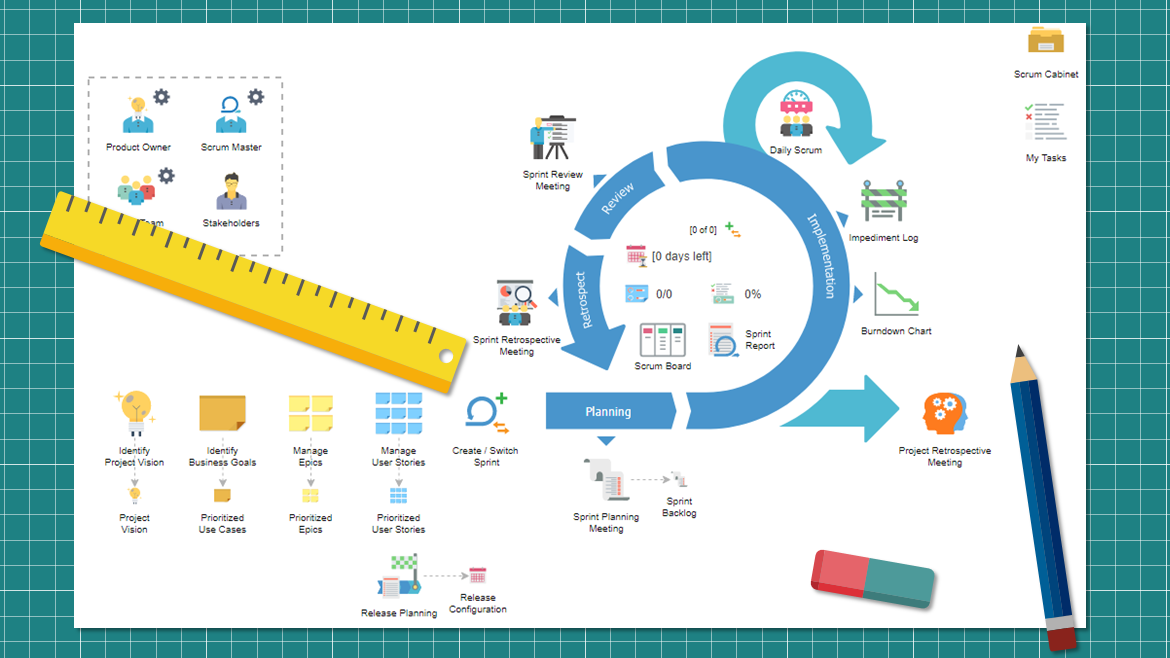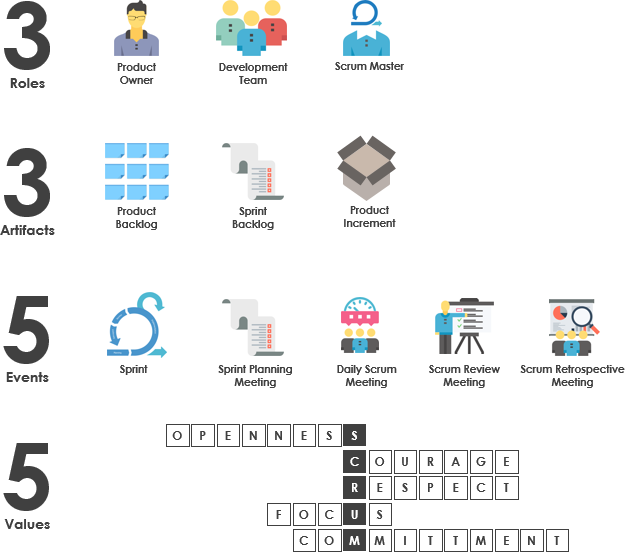Scrum 101: A Comprehensive Guide to Agile Project Management for Beginners
What is Scrum?
Scrum is a popular framework for agile project management. It is used for software development and other complex projects where requirements are constantly changing, and the team needs to be able to respond quickly to these changes. Scrum emphasizes collaboration, communication, and continuous improvement.

The Scrum Framework
The Scrum framework consists of the following 3 roles, 3 artifacts 5 events and 5 Values :

Roles:
- Product Owner: responsible for defining and prioritizing the product backlog, ensuring that the team is working on the most valuable features.
- Scrum Master: responsible for facilitating the Scrum events and coaching the team on the Scrum framework.
- Development Team: responsible for delivering a potentially shippable product increment at the end of each sprint.
Events:
- Sprint: a time-boxed period (usually 2-4 weeks) during which the team works to deliver a potentially shippable product increment.
- Sprint Planning: a meeting at the beginning of each sprint where the team collaborates to define the sprint goal and plan the work for the sprint.
- Daily Scrum: a daily meeting where the team discusses progress, identifies obstacles, and plans the work for the day.
- Sprint Review: a meeting at the end of each sprint where the team demonstrates the product increment to the stakeholders and receives feedback.
- Sprint Retrospective: a meeting at the end of each sprint where the team reflects on the previous sprint and identifies areas for improvement.
Artifacts:
- Product Backlog: an ordered list of features, bugs, and technical improvements that represent the requirements for the product.
- Sprint Backlog: a subset of the product backlog that represents the work that the team plans to complete during the sprint.
- Product Increment: the sum of all the completed product backlog items at the end of each sprint.
Values:
- Openness: Scrum values openness and transparency in communication, decision-making and problem-solving. This includes being open to feedback, sharing information and discussing any issues that arise.
- Courage: Scrum values the courage to take risks, to be honest about issues and to address problems directly. This includes the courage to admit mistakes, to ask for help when needed, and to challenge the status quo in order to continuously improve.
- Respect: Scrum values respect for all team members, regardless of their role or background. This includes respecting each other’s opinions and ideas, as well as respecting the Scrum framework and the process.
- Focus: Scrum values the importance of focus and concentration on the task at hand. This means avoiding distractions and maintaining a clear vision of the sprint goal.
- Commitment: Scrum values the commitment of the team members to the project and to each other. This includes committing to the sprint goals, to the team’s values and to the Scrum process itself.
How Scrum Works
The Scrum framework works by breaking down the work into small, manageable chunks that can be completed within a single sprint. At the beginning of each sprint, the team collaborates to define the sprint goal and plans the work for the sprint. During the sprint, the team holds daily Scrum meetings to discuss progress, identify obstacles, and plan the work for the day.
At the end of each sprint, the team demonstrates the product increment to the stakeholders during the Sprint Review meeting. The team then reflects on the previous sprint during the Sprint Retrospective meeting, identifying areas for improvement and making adjustments to the process as needed.
Throughout the process, the Product Owner works with the team to prioritize the product backlog, ensuring that the team is working on the most valuable features first. The Scrum Master facilitates the Scrum events and coaches the team on the Scrum framework, helping to ensure that the team is following the process and making continuous improvements.
The Lifecycle of a Scrum Process in 8 Steps
- Product Backlog – The Scrum process starts with the product backlog. This is an ordered list of all the features, bugs, and technical improvements that the team needs to deliver for the product. The product backlog is owned and managed by the Product Owner, who is responsible for prioritizing the items in the backlog based on their value to the customer and the business.
- Sprint Planning – At the beginning of each sprint, the team holds a sprint planning meeting. This is a collaborative session where the team reviews the product backlog and selects the items they will work on during the sprint. The team then creates a sprint goal, which is a clear and concise statement that summarizes the objective of the sprint.
- Sprint – During the sprint, the team works to complete the items selected during the sprint planning meeting. The sprint typically lasts 2-4 weeks, and the team meets daily in a short meeting called the Daily Scrum. The purpose of the Daily Scrum is to provide a quick update on progress, identify any obstacles or issues, and plan the work for the day.
- Sprint Review – At the end of the sprint, the team holds a sprint review meeting. This is an opportunity for the team to demonstrate the work they have completed during the sprint to stakeholders, such as the Product Owner, customers, and other interested parties. The team receives feedback on the product increment and incorporates it into the product backlog.
- Sprint Retrospective – Following the sprint review, the team holds a sprint retrospective meeting. This is a time for the team to reflect on the sprint and identify areas for improvement. The team reviews what went well, what could have been better, and creates a plan to address any issues or obstacles they encountered.
- Product Increment – At the end of each sprint, the team produces a product increment. This is a version of the product that includes all the completed items from the sprint. The product increment is potentially shippable, meaning that it meets the team’s definition of done and can be delivered to customers if needed.
- Product Backlog Refinement – Throughout the Scrum process, the Product Owner continually refines the product backlog. This includes adding new items, updating priorities, and clarifying requirements. The team may also contribute to product backlog refinement by asking questions or providing feedback.
- Continuous Improvement – The Scrum process is designed to be iterative and adaptive, with a focus on continuous improvement. The team regularly reflects on their processes and identifies areas for improvement, making adjustments as needed. By embracing a culture of continuous improvement, the team can continually enhance their productivity and effectiveness.
In summary, the Scrum process begins with the product backlog, which is reviewed and refined by the Product Owner. The team selects items to work on during the sprint planning meeting and works on them during the sprint. At the end of the sprint, the team holds a review and retrospective meeting, and produces a product increment. Throughout the process, the team focuses on continuous improvement, refining their processes and practices to deliver a high-quality product.
Benefits of Scrum
Scrum offers several benefits for agile project management, including:
- Increased flexibility: Scrum allows for changes in requirements and priorities to be accommodated quickly and efficiently.
- Enhanced collaboration: Scrum emphasizes collaboration and communication among team members, helping to ensure that everyone is working towards a common goal.
- Improved transparency: Scrum provides visibility into the progress of the project, allowing stakeholders to track progress and make informed decisions.
- Greater predictability: Scrum allows for more accurate forecasting of project timelines and budgets, helping to ensure that projects are completed on time and within budget.
Conclusion
Scrum is a powerful framework for agile project management that emphasizes collaboration, communication, and continuous improvement. By breaking down work into small, manageable chunks and delivering a potentially shippable product increment at the end of each sprint, Scrum allows teams to be more flexible, collaborative, and transparent in their approach to project management. With its emphasis on prioritization and continuous improvement, Scrum can help teams to deliver higher quality products more efficiently, while also providing greater predictability and transparency to stakeholders.
If you’re new to Scrum, it can be helpful to seek out training or certification programs to learn more about the framework and how to apply it effectively in your work. There are also many resources available online, including books, blogs, and videos, that can help you to deepen your understanding of Scrum and how it can benefit your team and your organization.
Ultimately, Scrum is a powerful tool for agile project management that can help teams to be more collaborative, efficient, and effective in delivering high-quality products that meet the needs of their users and stakeholders. By embracing the principles of Scrum and working together to continuously improve, teams can achieve greater success in their projects and drive meaningful results for their organizations.

